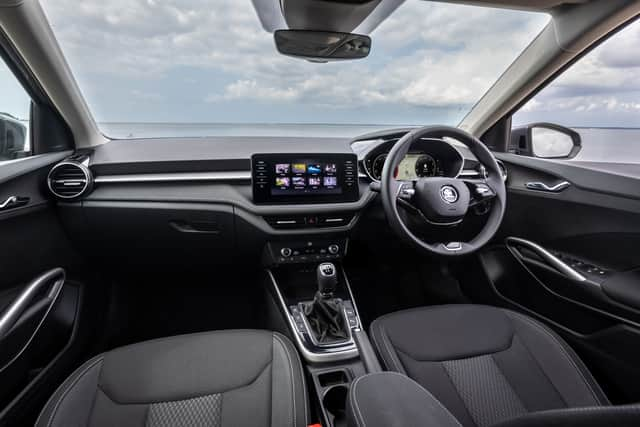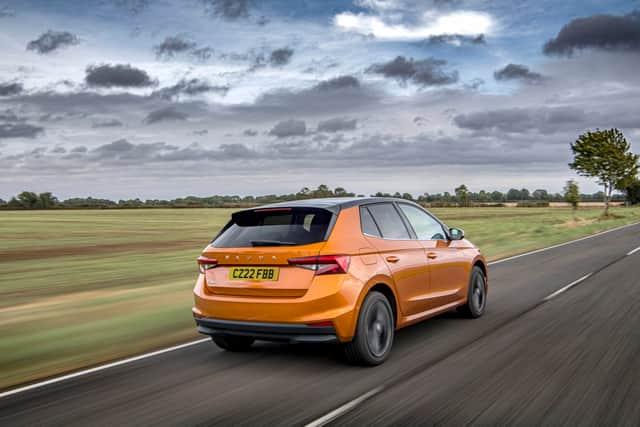2022 Skoda Fabia review: Do big car charms make this the best supermini on sale?


The Skoda Fabia is one of the cars that really helped establish the Czech brand as a serious player in the mainstream market.
Launched 23 years ago the Fabia’s blend of space, value and quality over three generations has been instrumental in transforming the brand from the butt of automotive jokes into a key part of the VW Group.
Advertisement
Hide AdAdvertisement
Hide AdLike its predecessors, the fourth generation of Skoda’s supermini takes the fight to the likes of the Ford Fiesta, Vauxhall Corsa and Toyota Yaris, and this time is armed with the latest in platform, engines and technology.
Based on the same MQB-A0 platform as the current VW Polo and Seat Ibiza, the Fabia is bigger than ever and offers class-leading space and practicality. It’s 10cm longer and 5cm wider than the previous generation and now has a longer wheelbase than the first generation Octavia. That translates into more room for passengers in the front and back plus a huge-for-the segment boot of 380 litres. Its rivals have grown over the years as well but none can match the feeling of space or comfort and the Fabia continues to do the “big small car” thing better than any of them.


That goes for the interior ambiance as well which, despite its supposed value positioning, feels more high-end than most rivals. It lacks the colour and slightly more adventurous styling of the Ibiza or Corsa but shares some of the more mature premium feel of the Octavia - from the knurled “metal” controls to the fabric finish on the dashboard. The gloss black plastic and bright chrome finishers work well and overall it feels a step above a Fiesta, Yaris or Clio.
As a B-segment car it misses out on the worst excesses of the VW’s group’s mission to destroy all buttons. Much of the car is controlled via its 9.2-inch touchscreen but there are still actual physical controls for the heating and lighting and the lane assist can be deactivated via a simple steering wheel button rather than three layers of menus. The screen is big and bright but the interface - once a strong point - is overly complex and you’ll be glad of the option to use Android Auto or Apple CarPlay.
Advertisement
Hide AdAdvertisement
Hide AdDespite being the brand’s entry level model, that new platform means the Fabia can be specified with driver aid technology such as adaptive cruise control, lane keep assist and the latest forward collision detection and mitigation systems.
Under the bonnet, the latest Fabia has more choice than before, as long as you want petrol. Four engines from the Group’s EVO range run from a basic 79bhp 1.0-litre up to a 148bhp 1.5-litre.
Here we’re testing the turbocharged 1.0-litre with 108bhp, which feels like a decent match for the car unless you’re desperate to go chasing down ST-Line Fiestas (which you shouldn’t). With a 0-62mph time of nearly 10 seconds, its performance is steady rather than stellar but with 148lb ft of torque it can move the Fabia along pretty well and without too much noise, plus return 50mpg.
Our car was fitted with the optional seven-speed DSG auto, which felt less suited to the car. It feels clunky and slow, especially at low speeds, where it gets caught out in the wrong gear in its pursuit of fuel economy. At higher speeds it’s smoother but I’d still save £1,000 and opt for the six-speed manual, which also offers better economy and CO2 emissions.
Advertisement
Hide AdAdvertisement
Hide AdThe gearbox doesn’t help the driving experience but overall the Fabia isn’t a car for driving enthusiasts or for chasing those sporty Fiestas. The big car feel pays off in the way it feels eminently stable and solid on the road but it’s also fairly heavy and inert compared to the more engaging Ford Fiesta and Toyota Yaris. The flip side to that is it’s far more comfortable and composed, with supple suspension that is better at dealing with potholed urban roads.
The Fabia range starts at £17,800 for an SE Comfort model with the 79bhp engine while our SE L model started life at £21,335 before options pushed that up to £24,440. Equipment levels are more or less in line with its key rivals, with features such as keyless entry, dual-zone climate control, cruise control and front assist and lane assist standard. As ever, Skoda adds a few “simply clever” features such as smartphone pockets on the seatbacks and a USB port in the rear view mirror to power a dash cam.


The latest Fabia isn’t perfect. Some rivals are more fun, look better or offer better economy. But like its predecessors, it’s a consummate all-rounder that strikes a great balance between those rivals. It offers loads of space, a more sophisticated interior and big car levels of comfort and composure for a competitive price and proves just how far the brand has come in the last 23 years.
Skoda Fabia SE L
Price: £21,335 (£24,440 as tested); Engine: 1.0-litre, three-cylinder, turbo, petroll Power: 108bhp; Torque: 148lb ft; Transmission: Seven-speed DSG auto; Top speed: 127mph; 0-62mph: 9.9 seconds; Economy: 47.1-50.4mpg; CO2 emissions: 128-137g/km
Comment Guidelines
National World encourages reader discussion on our stories. User feedback, insights and back-and-forth exchanges add a rich layer of context to reporting. Please review our Community Guidelines before commenting.
